
The 1st Infantry Division (1ID) is a combined arms division of the United States Army, and is the oldest continuously serving division in the Regular Army. It has seen continuous service since its organization in 1917 during World War I. It was officially nicknamed "The Big Red One" after its shoulder patch and is also nicknamed "The Fighting First." The division has also received troop monikers of "The Big Dead One" and "The Bloody First" as puns on the respective officially sanctioned nicknames. It is currently based at Fort Riley, Kansas.

The South African Army is the principal land warfare force of South Africa, a part of the South African National Defence Force (SANDF), along with the South African Air Force, South African Navy and South African Military Health Service. The Army is commanded by the Chief of the Army, who is subordinate to the Chief of the SANDF.
The 1st South African Infantry Division was an infantry division of the army of the Union of South Africa. During World War II the division served in East Africa from 1940 to 1941 and in the Western Desert Campaign from 1941 to 1942. The division was disbanded on 1 January 1943, for conversion into what would become the 6th South African Armoured Division. The division was also briefly active after the war from 1 July 1948 to 1 November 1949.

The 5th Canadian Division is a formation of the Canadian Army responsible for the command and mobilization of most army units in the provinces of New Brunswick, Nova Scotia, Prince Edward Island and Newfoundland and Labrador; as well as some units in Kingston, Ontario. The division is recognized by the distinctive maroon patch worn on the sleeve of its soldiers.

The Battle of Delville Wood(15 July – 3 September 1916) was a series of engagements in the 1916 Battle of the Somme in the First World War, between the armies of the German Empire and the British Empire. Delville Wood (Bois d'Elville), was a thick tangle of trees, chiefly beech and hornbeam, with dense hazel thickets, intersected by grassy rides, to the east of Longueval. As part of a general offensive starting on 14 July, which became known as the Battle of Bazentin Ridge (14–17 July), General Douglas Haig, Commander of the British Expeditionary Force, intended to capture the German second position between Delville Wood and Bazentin le Petit.
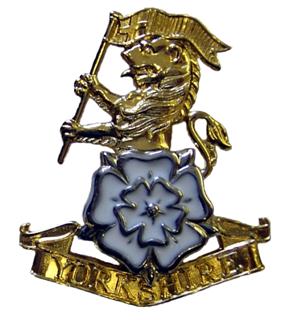
The Royal Yorkshire Regiment is an infantry regiment of the British Army, created by the amalgamation of three historic regiments in 2006. It lost one battalion as part of the Army 2020 defence review. The regiment's recruitment area covers the ceremonial counties of the East Riding of Yorkshire, North Yorkshire, South Yorkshire and West Yorkshire; areas near Barnsley are recruitment area for the Rifles.

The Rifle Brigade (The Prince Consort's Own) was an infantry rifle regiment of the British Army formed in January 1800 as the "Experimental Corps of Riflemen" to provide sharpshooters, scouts, and skirmishers. They were soon renamed the "Rifle Corps". In January 1803, they became an established regular regiment and were titled the 95th Regiment of Foot (Rifles). In 1816, at the end of the Napoleonic Wars, they were again renamed, this time as the "Rifle Brigade".

The Solomon Mahlangu Regiment is a reserve infantry regiment of the South African Army.

The Cape Town Highlanders is a reserve mechanised infantry regiment of the South African Army.

The South African Army Infantry Formation supervises all infantry within the South African Army.

Andrew Mlangeni Regiment is a reserve infantry regiment of the South African Army.

The Kimberley Regiment is an infantry regiment of the South African Army. As a reserve unit, it has a status roughly equivalent to that of a British Army Reserve or United States Army National Guard unit.
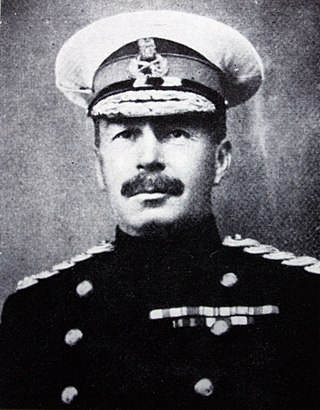
Major-General Sir Henry Timson Lukin was a South African military commander. He fought in the Anglo-Zulu War (1879) and the Basutoland Gun War (1880–1881), the Bechuanaland Campaign (1897), and the Anglo-Boer War when he was in command of the artillery during the defence of Wepener for which action he was awarded a Distinguished Service Order. From 1900 to 1901 he commanded the Cape Mounted Riflemen, from 1904 to 1912 he was Commandant-General of the Cape Colonial Forces and in 1912 Inspector-General of the Permanent Force of the Union of South Africa.
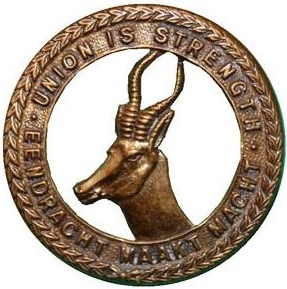
The South African Overseas Expeditionary Force (SAOEF) was a volunteer military organisation in World War I.

The South African 1st Infantry Brigade was an infantry brigade of the army of the Union of South Africa during World Wars I and II. During World War I, the brigade served as a British formation in Egypt and on the Western Front, most famously the Battle of Delville Wood. It was reactivated at the start of the Second World War as a South African formation and served in East Africa and the Western Desert; the brigade disbanded on 1 January 1943.
The 2nd South African Infantry Brigade was an infantry brigade of the army of the Union of South Africa during World War II. The Brigade formed part of the 1st South African Infantry Division and was formed on 13 August 1940. It served in East Africa and the Western Desert and was disbanded on 1 January 1943.
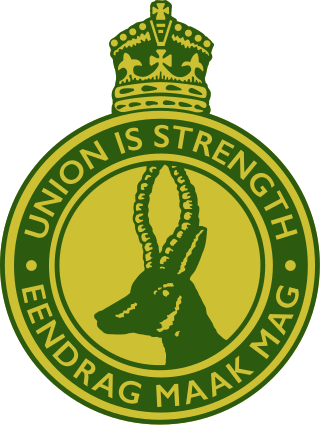
The Union Defence Force (UDF) comprised the armed forces of South Africa from 1 July 1912, when the Defence Act took effect, two years after the creation of the Union of South Africa, until 1957 when it was reorganised and renamed the South African Defence Force.

2nd South African Infantry Regiment was an infantry regiment of the South African Overseas Expeditionary Force during the First World War.
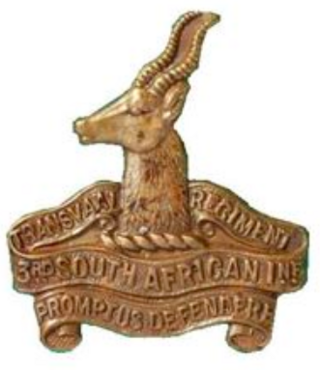
The 3rd South African Infantry Regiment was an infantry regiment of the South African Overseas Expeditionary Force during the First World War.

4th SA Infantry Regiment was an infantry regiment of the South African Army, during World War One.


















